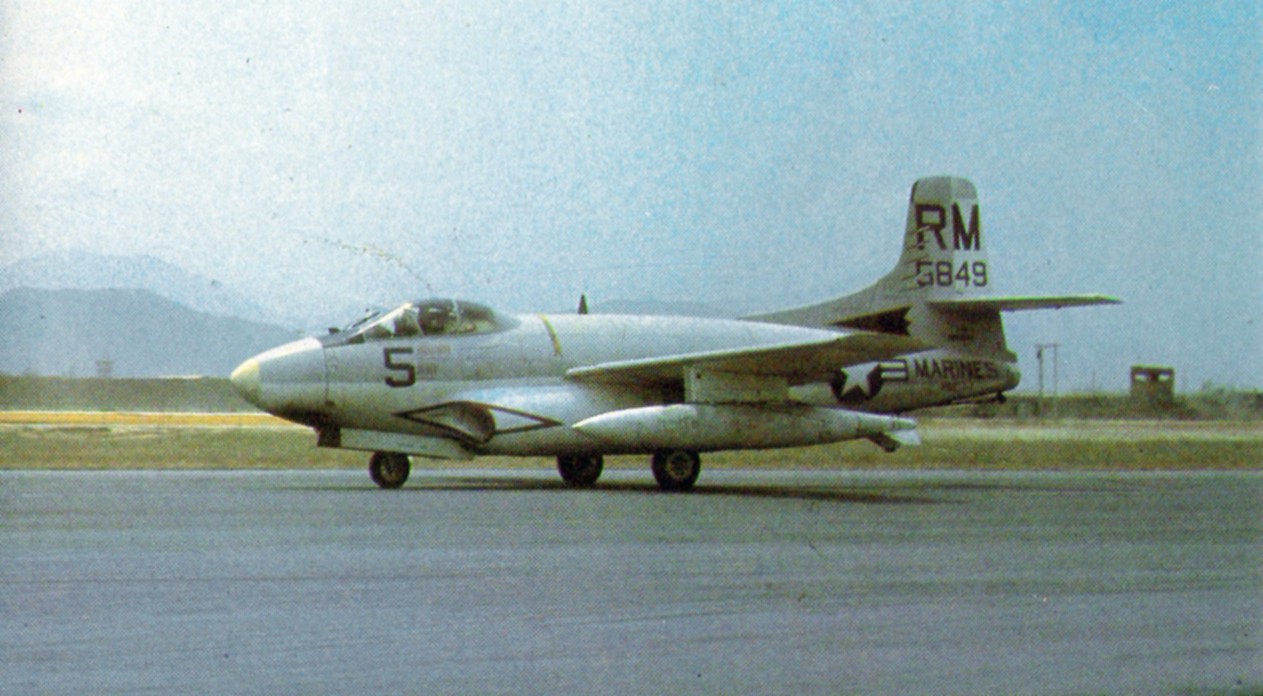In late January 1965, VMCJ 1 marked a single EF 10B Skyknight with some interesting graffiti that raised eyebrows both in the USSR and at home.
The Douglas F3D Skyknight was an early but effective attempt at combining new technologies together in a lethal package capable of shipboard operation. Whereas most fighters relied on speed and maneuverability, the portly, straight-winged F3D relied on three radars, four 20mm cannons, and – most importantly – darkness. Having first flown in March 1948, the Skyknight’s first taste of war came in September 1952, when Marine Night Fighter Squadron 513 [VMF(N)-513] deployed to Korea.
After the war, 35 Skyknights were converted into F3D-2Q electronic warfare (EW) aircraft.
As told by Joe Copalman in his book F3D/EF-10 Skyknight Units of the Korean and Vietnam Wars, although crews flying ‘Shark Fin’ missions [as Peacetime Aerial Reconnaissance Program (PARPRO) missions to collect intelligence on radar systems in China, North Korea, and the Soviet far east] remained in international airspace and relied on standoff receivers to collect intelligence, communist air arms from the nations being spied on routinely sent MiGs up to intercept and investigate the surveillance flights. In most cases, these intercepts involved MiGs harmlessly flying wings on an F3D-2Q before turning back. Recalling one such peaceful intercept, Skyknight pilot Chuck Houseman said;
‘The first time we were intercepted, they reported that we were taking pictures of them, as we were carrying 35 mm hand-held cameras. Normally, it would be on the pilot’s side where the interceptors were, and the ECMO would lean across and snap some pictures of them. And the Russians would report, “They’re taking pictures of us. What should we do?” One of the Russian controllers had a sense of humor and said “Smile”. Who would have thought the Russians had any sense of humor at all?’
As amicable as intercepts with Soviet MiG pilots could be, pilots from other communist nations in the region were decidedly humorless. In his book Top Secret, ECMO J T ‘Jerry’ O’Brien wrote;
‘One didn’t wave at the Chinese or North Koreans. We went to some lengths to avoid contact with the Koreans and the Chinese. On flights from Taiwan, we were usually covered by a flight of Chinese Nationalist F-86s.’

On Jun. 16, 1959, the North Korean People’s Air Force (NKPAF) MiG-17s attacked a US Navy P4M-1Q Mercator flying an electronic reconnaissance mission 50 miles off the east coast of Korea. While its crew managed to recover safely in Japan, despite the aircraft being heavily damaged (it was later declared a write-off) and the tail gunner being wounded, the attack – which occurred while US Marine Corps Skyknight crews were flying similar missions – drove home the serious turns these flights could take. Although the Marine Composite Reconnaissance Squadron (VMCJ) aircrews managed to avoid such unpleasantness, one particular PARPRO mission drew a fire of another sort from an unexpected source – the US National Security Agency (NSA).
In late January 1965, VMCJ-1 marked a single EF-10B with some interesting graffiti that raised eyebrows both in the USSR and at home. Chuck Houseman, who flew the marked-up aircraft on a ‘Shark Fin’ toward Vladivostok, recalled;
‘This was not authorized, but we thought we’d jazz up the situation a little bit, so we somehow or another were able to come up with the Russian language that said ‘JOIN THE U.S. MARINE CORPS’ and painted it on the side of the fuel tanks on the F-10s [the F3D-2Q had been redesignated the EF-10B in September 1962]. There was a conversation, and we learned later on when the interceptors came up – they got a little closer than usual and were reading it off to the ground controller. They reported it, and there was no response, so they reported it again, and there was still no response, so they dropped it.
‘The painting on the fuel tanks caused some big turmoil in the background in Washington, D.C., with the NSA wondering what the hell was going on. By the time the information rolled down to us, the second flight was up there with those same markings, and they didn’t want to turn him around when he was already on his way out, but they passed the word down, “Paint that damned thing over and get rid of it”.’
Judicious flying helped prevent MiG encounters, with pilots denying intercepts by beginning their turns back toward Japan before the relatively short-legged MiGs could close the distance on them. As EF-10B pilot then Capt Art Bloomer recalled from his 1961–62 tour with VMCJ-1;
‘I flew a lot of the “Shark Fin” missions out of Misawa, where we headed straight out towards Vladivostok, getting to within 20 miles of it. I never did get intercepted, as I was always turned before then, and we’d have MiGs on our tail. They followed us for 50–60 miles out to sea when we were headed back to Misawa, then they would break off and go somewhere else.’
F3D/EF-10 Skyknight Units of the Korean and Vietnam Wars is published by Osprey Publishing and is available to order here.

Photo by U.S. Navy and U.S. Air Force

